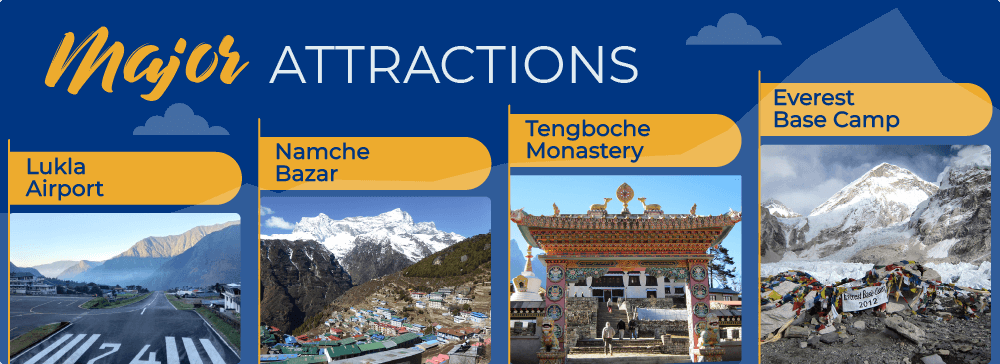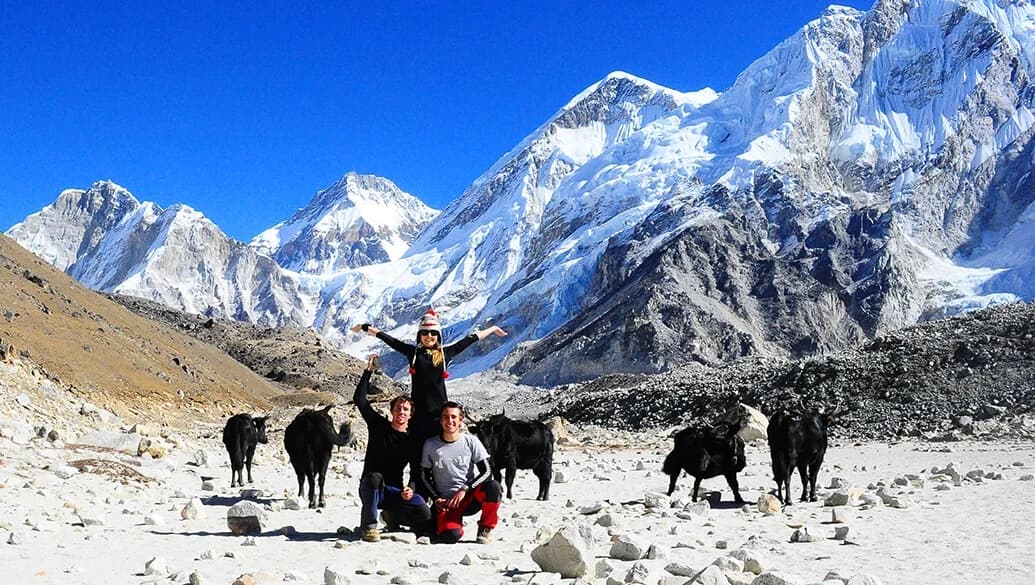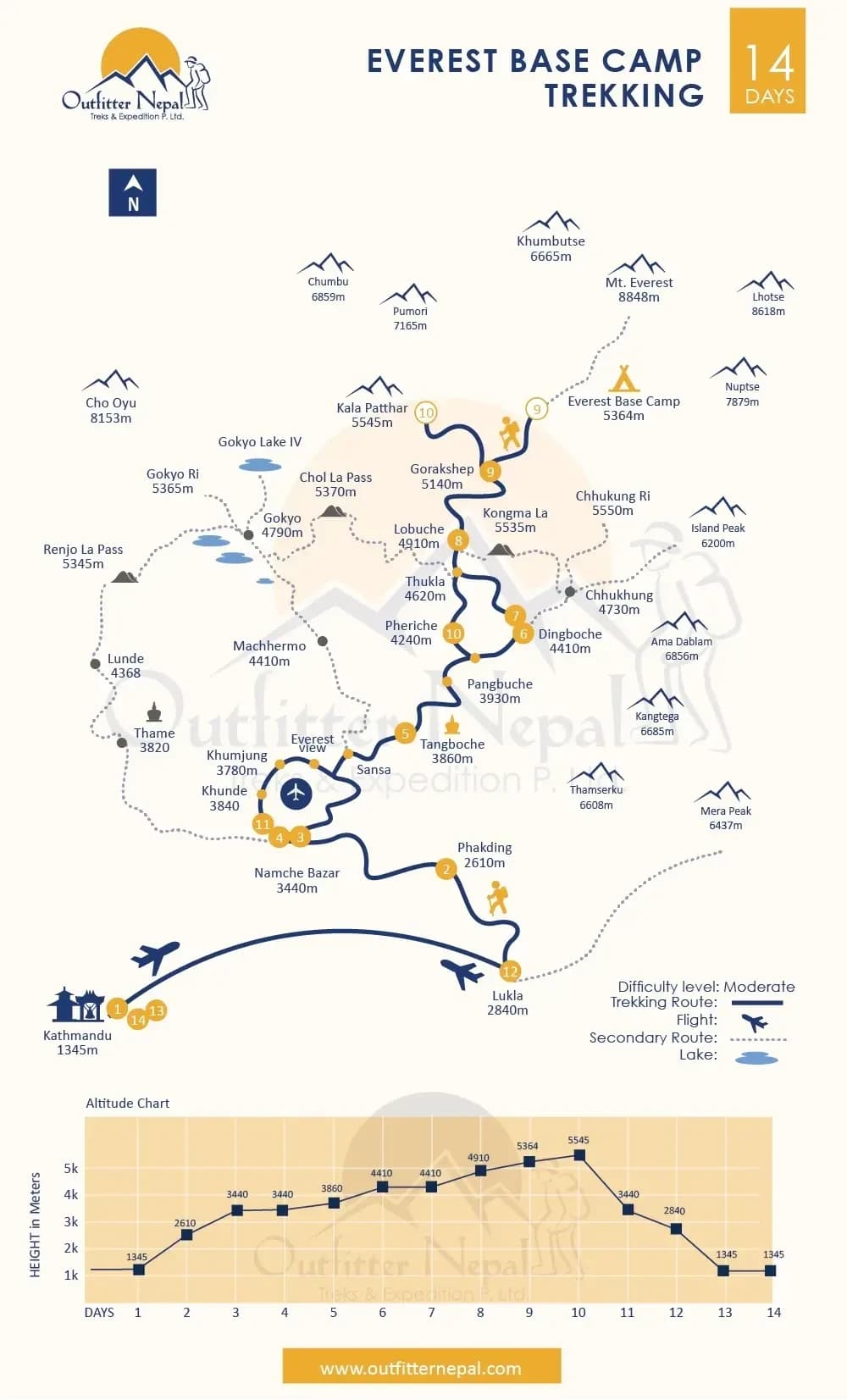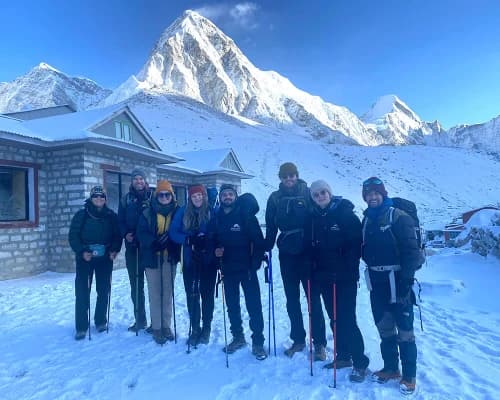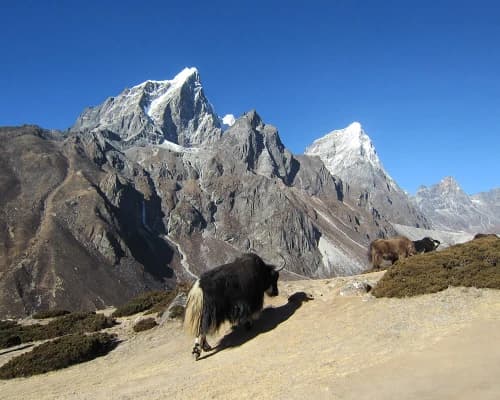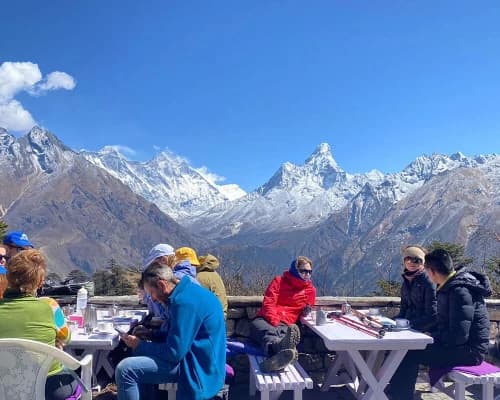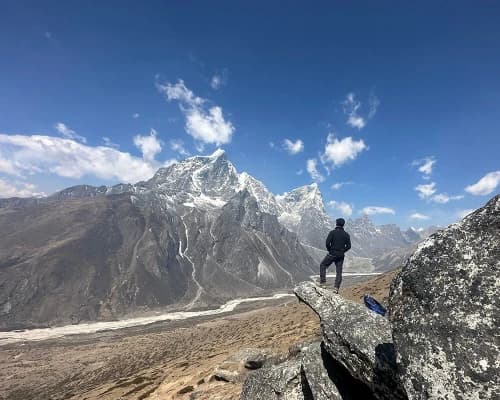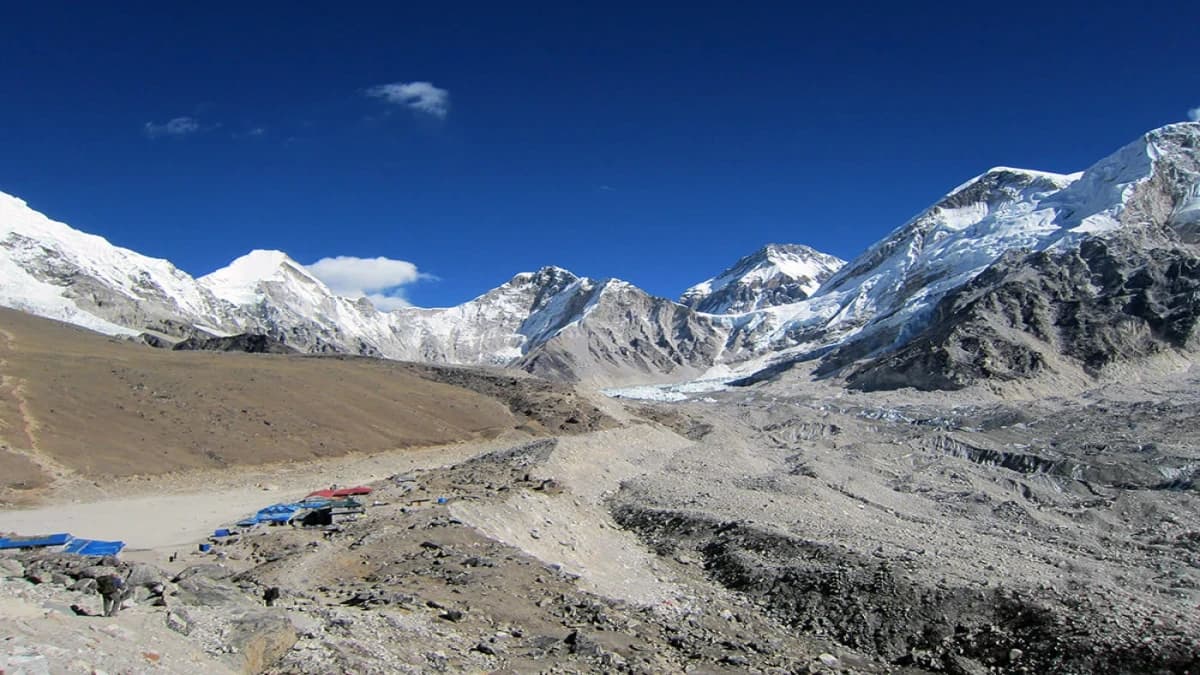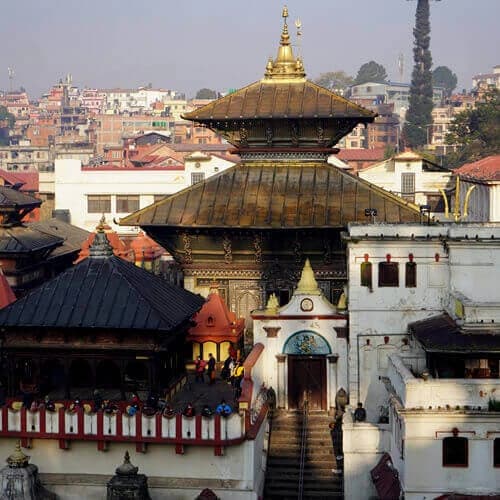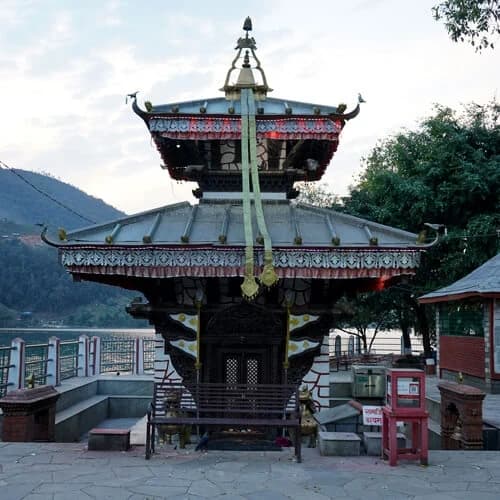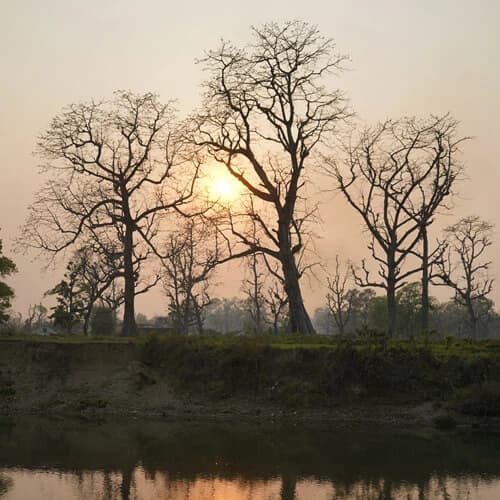14 Days Everest Base Camp Trek Highlights
- Kick start your Everest adventure with an exhilarating mountain flight to Lukla airport, one of the highest airstrips in the world.
- Trek with confidence, your journey will be supported by experienced, government-licensed guides native to the Everest region.
- Stand triumphantly on the vantage point of Kala Patthar (5,555m / 18,225 ft) and witness the sunrise illuminating over Mount Everest and other majestic snow-capped peaks.
- Reach the iconic Everest Base Camp, and feel the immense grandeur of the Khumbu Glacier and icefalls. Stand in awe, as this is your milestone after hiking for multiple days on varied terrains.
- Explore the sacred Khumbu/Everest region and visit ancient Buddhist heritage sites, such as Tengboche monastery, to learn about the spiritual culture of the local people.
- Mesmerizing views of Ama Dablam (6,812 m/22,349 ft), Lhotse (8,516 m/27,940 ft), Nuptse (7,861 m/25,791 ft), Thamserku (6,623 m/21,713 ft), and Cho Oyu (8,201 m/26,906 ft) surround you at every turn of the trek.
- Explore the vibrant Namche Bazaar and savor a warm apple pie at a cozy restaurant during the day of acclimatization, accompanied by a visit to the Hotel Everest View.
- Witness vast mountain ranges of the Everest region during the short hike to Nangkartshang Peak (5083m/16,676ft).
- Experience the wilderness of Sagarmatha National Park, and hike through the dense forest of rhododendron and juniper.
- An adrenaline-rushing experience at long suspension bridges adorned with colorful prayer flags.
Overview of the Everest Base Camp Trek 14 Days
Trekking to the base camp of Mount Everest (8,848.86 m/29,029.2 ft), the world's highest peak, is a 14-day high-altitude journey through the legendary Everest/Khumbu region of Nepal. The trek is considered an iconic adventure trail, as it retraces the footsteps of mountaineering pioneers like Tenzing Norgay and Sir Edmund Hillary.
You will be entering the Sagarmatha National Park, a UNESCO World Heritage Site. It is a protected region renowned for its natural diversity and beauty. As you follow the route ahead, the landscape transitions from terraced hills and lush forests to rugged, isolated terrain and dramatic glacial moraines. Therefore, it is essential to layer your clothing to accommodate the changing weather conditions as you make your way to the Everest Base Camp.
In this expedition, you will ascend to Kala Patthar(5,555m/18,225 ft), the highest point of the trek. Reaching the vantage point, you feel the adrenaline of achievement and enjoy a spectacular close-up view of Mount Everest. Along the way, travelers will also enjoy unparalleled vistas of four of the world's six highest peaks, including Mt. Lhotse, Mt. Makalu, and Cho Oyu.
Your adventure begins with a breathtaking 30-minute flight from Kathmandu to Lukla Airport, the gateway to the Everest region. The trek to the EBC starts along the banks of the Dudh Koshi River, and after crossing a suspension bridge, you will proceed to the village of Phakding. This is the first stop of the trek, which provides you with a close look at the daily lifestyle high in the mountains.
In the coming days, you will stop by several Sherpa villages, including the vibrant Namche Bazaar, Tengboche, Dingboche, Lobuche, Gorakshep, Pheriche, Khunde, Khumjung, and Phortse. Staying overnight at the teahouses in these settlements brings you closer to the rich culture and tradition of the native Sherpa community. This is the perfect opportunity to learn about their heritage and enjoy local delicacies, such as Tsampa, Shyakpa, and butter tea.
The region's trail is dotted with prayer wheels, mani walls, and religious sites, including the Tengboche and Pangboche monasteries. This encounter allows you to learn and immerse yourself in the spirituality and spiritual practices of Tibetan Buddhism in the region. We recommend traveling to the Everest region in October or November to experience the vibrant Mani Rimdu festival.
Pre-trek briefing:
Before the Everest Base Camp Trek, we will have a meeting at our office. During the briefing, our travel planner, Raj Basnet, will provide an overview of the trip and address any questions you may have. This is also the perfect opportunity to meet your guide and check if you are fully prepared.
Kalapatthar, A Spectacular Vantage Point for Epic Everest Views
The hike to Kala Patthar, also known as Black Rock, is the emotional pinnacle of the Everest Base Camp Trek. Trekkers rise early in the morning, before sunrise, in the freezing darkness of the Himalayas to capture the most dramatic sunlight over the mountains. The ascent is demanding due to the cold weather and icy terrain. But with the appropriate clothing and equipment, such as a flashlight and trekking poles, you'll be able to navigate safely. Additionally, our first-aid trained guide will lead the way at a slow and gradual pace, monitoring your vital signs with a Pulse Oximeter.
Reaching the rocky perch of Kala Patthar is a monumental reward after pushing yourself through the entire journey. You have earned this moment, and you can now truly witness the majestic grandeur of the world's tallest peak. As the sun breaks the horizon, you are granted the unparalleled views of the golden summit towering before you. From the vantage point, trekkers will have a front row seat to the vista of Everest, Lhotse, Makalu, and Cho Oyu, four of the world's six highest peaks surrounding the Khumbu Valley. This awe-inspiring moment is reserved for those who successfully face the challenges of high-altitude trekking. It offers you a profound achievement and memories you can cherish for a lifetime.
Lukla Flight Information about 14 Days EBC Trek
Please be informed that all flights to Lukla from Kathmandu will be operated from Manthali Airport in Ramechhap during the peak seasons of autumn (September, October, and November) and spring (March, April, and May). Travelers will need to take a 4-5 hour bus journey from Kathmandu to Manthali and then board a flight to Lukla Airport. This change has been made due to the high volume of travelers during the specified months. Whereas, the flights will operate on the usual basis from Kathmandu to Lukla during the winter season (December, January, February) and the monsoon season (June, July, August).
Keep an Extra Two Days for Lukla’s Flight Delays
Our standard 14 Days Everest Base Camp itinerary may be affected by unpredictable weather events, which can cause flight cancellations and delays. Additionally, factors such as natural calamities, political affairs, and the trekker's health condition will also have a direct impact on the trip. To deal with such circumstances, it would be wise to add two buffer days to your travel plans to avoid any complications. The extra days give you the time to relax and enable us to make changes to the trek route or arrange a helicopter return, as per your decision.
Hiking to Everest Base Camp - What it's Really Like
Imagine yourself amidst the green hills of Lukla, where the crisp mountain air greets you, setting the stage for your high-altitude adventure ahead. The trail takes you along the Dudh Koshi River and enters Sagarmatha National Park, where you may encounter elusive wildlife, including the Himalayan Tahr and Snow Leopard. As you ascend higher, you are welcomed by spectacular views of peaks such as Ama Dablam, Lhotse, and the legendary Mount Everest.
The trail winds through rhododendron and juniper forests, leading you to Sherpa settlements like Tengboche. The village is home to Tengboche Monastery, the largest in the region. You will explore sacred sites like these to immerse yourself in the spirituality and religious beliefs of the local people. Some of the cultural encounters you will experience include prayer meetings and meditation sessions with the monks. We highly encourage you to participate in the artistic practice by lighting candles, incense, and walking clockwise when passing mani walls or stupas.
As you ascend further on the trail, the landscape shifts from lush green forests to an alpine wonderland of ice and snow. The teahouses along the route are built with stone and wood, offering a warm shelter for travelers after a long day of trekking. There will be a large stove in the communal dining hall, where you can enjoy a hearty meal and share experiences with the rest of the trek members. In short, the Everest Base Camp Trekking is emotionally rich, as you immerse yourself in the local culture, engage with spirituality, push your body to its limit as you set foot on the EBC, and reach Kala Pathar with a sense of profound achievement.
Understanding the Everest Base Camp Trek Difficulty Level
How challenging is the Everest Base Camp Trek 14 Days? The short answer is trekking to the base camp of Mount Everest is strenuous and classified as level 5. It is physically demanding as you will be ascending to a high-altitude environment, but it's achievable for trekkers with a moderate fitness level. The trek itself is not technical, as you won't need ropes or ice axes. According to experts, the difficulty stems from altitude gain, duration, terrain, and unpredictable weather, which require proper preparation.
The 14-Day EBC Trek covers approximately 130 km (80 miles) from Lukla to Everest Base Camp and back. Expect to hike for at least 6-8 hours per day on rugged and steep terrain, with some longer days, especially during the ascent to higher regions. The significant increase in elevation exposes you to a rapid decrease in oxygen levels, which can lead to complications like acute mountain sickness (AMS). Some of the early symptoms include headaches, dizziness, nausea, insomnia, and shortness of breath. So, it is highly recommended to walk at a slow pace and take as many breaks as needed on the trail to allow your body to recover.
If you are physically prepared, listen to your body, and follow the instructions of our experienced guide, you can complete the EBC trek. However, if you try to rush your pace and ignore the signs of altitude sickness, you will be at high risk of struggling and exhaustion. Having said that, the EBC trek is safe and accessible if you treat it with respect. As a result, the journey becomes an enriching adventure in the majestic Himalayas of Nepal. If you are curious and want to learn about the specific factors that influence the challenging nature of the expedition, read our blog on Everest Base Camp Trek Difficulty for more insights
Physical Preparation: A Fitness Guide for Everest Base Camp Trekking
The EBC trek is one of the most sought-after destinations by travelers and adventurers from around the world. But it requires proper research, planning, and training to enjoy a seamless and comfortable trek experience. It is also worth noting that the trek is suitable for beginners, and people of all ages (12 to 70+) with a few months of preparation.
At Outfitter Nepal, with the proper guidance and support, anyone with a reasonable fitness level will be able to trek to the iconic EBC. We highly recommend that all participants undergo physical conditioning and training before starting this adventure. By committing to a 3-month workout routine, you can enhance your overall fitness level and make the experience enjoyable and rewarding.
For your convenience, we have compiled the following strategies and suggestions to help you prepare for the EBC trek.
Physical Preparation
If you are not fit, it is highly recommended to be active every day, and exercise at least 2-3 times a week. Focus on enhancing your stamina and core muscle strength to be able to walk long hours on the steep terrains of the Everest region. Include workouts and activities such as jogging, stair climbing, cycling, swimming, lunges, squats, and weightlifting in your daily exercise routine. It is also equally important to get enough sleep, stay hydrated, and maintain a balanced diet to replenish your body.
Mental Preparation
Trekking to Everest Base Camp is not only physically difficult but also mentally demanding. On the trail, you will face unpredictable weather, rough terrain, and physical exhaustion, and it will be crucial to prepare mentally for such unexpected situations and discomforts. We recommend that you stay positive, calm, and motivate yourself to build a strong mindset. Additionally, practicing mindfulness through yoga and meditation before or after the trek is beneficial.
If you want to learn more about how you can prepare yourself for the EBC trek, read our blog on How to prepare for the Everest Base Camp Trek for tips, practical insights, and expert advice.
How Do We Ensure Your Safety? Our Essential Acclimatization Strategy
The success behind every successful Everest Base Camp trek is following the slow ascent, hike high, and sleep low schedule. This strategy is designed to help your body adapt to the increasing altitude and low oxygen levels. We have designed our 14-day itinerary to include two rest days at crucial stops, encouraging your body to acclimate.
The first acclimatization day will be spent at Namche Bazaar (3,440m / 11,286 ft), during which you will hike to the Everest View Hotel (3,880 m/12,730 ft). The establishment is renowned as a vantage point to spectate Mount Everest with a warm beverage and other local delicacies. Similarly, the second rest day will be spent at Dingboche (4,410m / 14,468 ft), where trekkers will hike to Nangkartsang Peak (5,083 m/16,676 ft) to improve their acclimatization before ascending to 5,000m.
We offer the option to include additional rest days in the itinerary as needed. You will hike at your own pace, with the flexibility to customize the trip by taking detours and making route changes if needed. Furthermore, our team is available 24/7 to arrange a helicopter evacuation, ensuring you are transported to a healthcare facility in the event of a medical emergency.
How to Prevent Altitude Sickness on the Trail to Everest Base Camp
Acute motion sickness or altitude sickness can happen to anyone regardless of age and fitness level, posing a severe and fatal risk. So, you must examine yourself with a medical expert to assess any underlying medical condition, which might affect you during the trek. By taking this step, you will prevent any complications with your health, making it easier to deal with altitude sickness.
First and foremost, it is essential to maintain a slow and gradual pace, accompanied by plenty of hydration, during the trek. We recommend drinking at least 2 litres of water daily and avoiding substances such as alcohol and tobacco. Similarly, getting 8 hours of sleep and maintaining a diet rich in carbohydrates helps improve acclimation and revitalize the body. Besides, medications like Diamox should only be taken under medical supervision, and travelers should consume natural remedies like garlic soup and ginger tea to soothe early symptoms such as dizziness and nausea.
Who will be Leading Your Trek to Everest Base Camp
The safety and success of our valued clients are ensured by our commitment to delivering high-quality service and exceptional hospitality. Expert leads our treks, experienced guides such as Indra Thapa and Amar Khan, Hom Bdr Khadka, Balaram Khadka, who specialize in operating treks in the Everest and other Himalayan regions of Nepal. Along with them, the rest of our guides have completed the EBC trek with a 95% success rate.
Our team comprises staff members who possess in-depth knowledge of the Everest region, its terrain, culture, and local history. The guides, who will lead you, are government-licensed and have years of practical trekking experience. They are also well-trained in wilderness first aid and will provide you with immediate medical attention in case of injury and altitude sickness.
Our guides will check your vitals daily to ensure your pulse rate and oxygen saturation remain stable. Their expertise and scientific approach in managing your overall health will address any concerns you might have, allowing you to trek with confidence. Check out our reviews to learn more about the wonderful experience our clients had with our guide during their travel in Nepal.
Why Choose Outfitter Nepal for 14-Day EBC Adventure?
You book a trek with us, you benefit from more than a decade of expertise and extensive knowledge. Since our establishment in 2009, we have successfully guided hundreds of treks in the Everest, Annapurna, Manaslu, Mustang, and Langtang regions of Nepal. This operational maturity is why our services are highly recommended for tourists of all ages, offering fully customizable packages tailored to individual fitness levels and experience, ensuring a responsible and safe journey.
Our commitment to exceptional trek management and genuine hospitality is validated by our customer loyalty. Almost 60% of our trekkers are repeat clients, and this metric speaks volumes about the quality of our personalized service and the success rates of our expeditions. We encourage you to learn more about the experiences of our past clients on review sites like TripAdvisor, Google, and social media platforms such as YouTube, Facebook, and Instagram.
We are a local, Nepal-based company, which means you can be assured of the best price with transparent costs and no unnecessary commission fees to third parties. Additionally, Outfitter Nepal strictly follows the standards set by governing bodies, including the Nepal Tourism Board (NTB), the Trekking Agencies Association of Nepal (TAAN), the Nepal Mountaineering Association (NMA), and the Kathmandu Environmental Education Project (KEEP).
By traveling with us, you will also be contributing to the sustainable development and prosperity of the region, aligning your adventure with ethical travel practices. Our commitment to responsible tourism ensures all of our trips have a positive impact on the environment and the local Khumbu communities.
Mount Everest Base Camp Trek Cost for 2026, 2027, and 2028
The Mount Everest Base Camp Trek Cost varies widely, depending on the season and the length of the expedition. In general, the Everest Base Camp Trip Cost ranges anywhere from $1295 to $1645, depending on the services and package you choose. If you want the standard package, it costs $1645 Single person, and if you are 2 to 4 people then trip Cost is 1350 USD per person We also provide our clients with special group discounts. If you are looking for laid-back and luxurious travel, we recommend the Everest Base Camp Luxury Trek. The price of our tour packages includes round-trip flights from Kathmandu/Remechhap to Lukla, permits, Food, Drinks, and accommodation etc. However, it will not include travel insurance, visa fees of Nepal, Wifi - Internet, and additional personal expenses.
